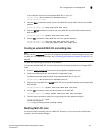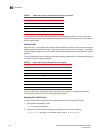
Dell Converged Enhanced Ethernet Administrator’s Guide 97
53-1002116-01
Queueing
10
Applying a CoS-to-CoS mutation QoS map
To apply a CoS-to-CoS mutation QoS map, perform the following steps from Privileged EXEC mode.
1. Enter global configuration mode.
switch#configure terminal
2. Specify the 10-gigabit Ethernet interface.
switch(config)#interface intengigabitethernet 0/2
3. Activate or apply changes made to the CoS-to-CoS mutation QoS map name. In this example
‘test’ is used.
switch(conf-if-te-0/2)#qos map cos-mutation test
4. Specify the trust mode for incoming traffic.
Use this command to specify the interface ingress QoS trust mode, which controls user priority
mapping of incoming traffic. The untrusted mode overrides all incoming priority markings with
the Interface Default CoS. The CoS mode sets the user priority based on the incoming CoS
value, if the incoming packet is not priority tagged, then fallback is to the Interface Default CoS
value.
switch(conf-if-te-0/2)#qos trust cos
5. Exit the configuration mode and return to EXEC mode.
switch(conf-if-te-0/2)#exit
switch(config)#end
6. Enter the copy command to save the running-config file to the startup-config file.
switch#copy running-config startup-config
Traffic class mapping
The Dell M8428-k supports eight unicast traffic classes for isolation and to control servicing for
different priorities of application data. Traffic classes are numbered from 0 through 7, with higher
values designating higher priority.
The traffic class mapping stage provides some flexibility in queue selection:
• The mapping may be many-to-one, such as mapping one byte user priority (256 values) to eight
traffic classes.
• There may be a non-linear ordering between the user priorities and traffic classes.
Unicast traffic
Table 18 presents the Layer 2 default traffic class mapping supported for a COS-based user priority
to conform to 802.1Q default mapping.
TABLE 18 Default user priority for unicast traffic class mapping
User priority Traffic class
01
10
22


















